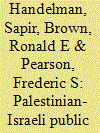| Srl | Item |
| 1 |
ID:
110031


|
|
|
|
|
| Publication |
2012.
|
| Summary/Abstract |
How can two peoples, engaged in a decades-long bloody conflict, break the cycle of violence, reconcile their divergent interests, and construct a reality devoid of the deep seated hatred permeating their respective communities? A novel initiative called 'The Minds of Peace Experiment' (MOPE) attempts to tackle this vexed question by bringing together regular Israelis and Palestinians to simulate the process of peace negotiations. Sitting before an audience and assisted by moderators, two mock delegations discuss the conflict and the steps they consider necessary if it is to come to a close. This article discusses the general nature of the MOPE, its stated goals, and procedure. It focuses on several significant themes that emerged from one particular instalment of the experiment. The aim is to evaluate the utility of the MOPE along two dimensions. First, in terms of its capacity to affect the dynamics of the conflict. Second, in terms of its adequacy as a model of a genuine major Palestinian-Israeli public assembly. It is argued that the MOPE is an important addition to various strategies for conflict resolution, though its effectiveness is hampered by several factors that demand attention.
|
|
|
|
|
|
|
|
|
|
|
|
|
|
|
|
| 2 |
ID:
110028


|
|
|
|
|
| Publication |
2012.
|
| Summary/Abstract |
This paper draws lessons from the role played by the black church in creating support for the US civil rights movement in relation to the struggle to involve the Palestinian and the Israeli people directly in the peacemaking efforts to resolve their tragic conflict. The civil rights struggle in both the US and South Africa eventually engaged large segments of the public in both productive debate and campaigning. The corresponding impetus now is to create a major Palestinian-Israeli public negotiating congress that can involve ordinary citizens on both sides in the peacemaking efforts. The Minds of Peace Experiment, a small-scale Palestinian-Israeli public negotiating assembly, is designed to demonstrate the peacemaking power of a subsequent major congress. The exercise, which has been conducted around the US, Canada, and the Middle East, succeeded in creating peacemaking coalitions that are based on commitment to promote the culture of peace. The question is: how can you transform this peacemaking effect into a mass movement? The American black church movement as well as the South African mass mobilization can offer important indications of effective strategy.
|
|
|
|
|
|
|
|
|
|
|
|
|
|
|
|